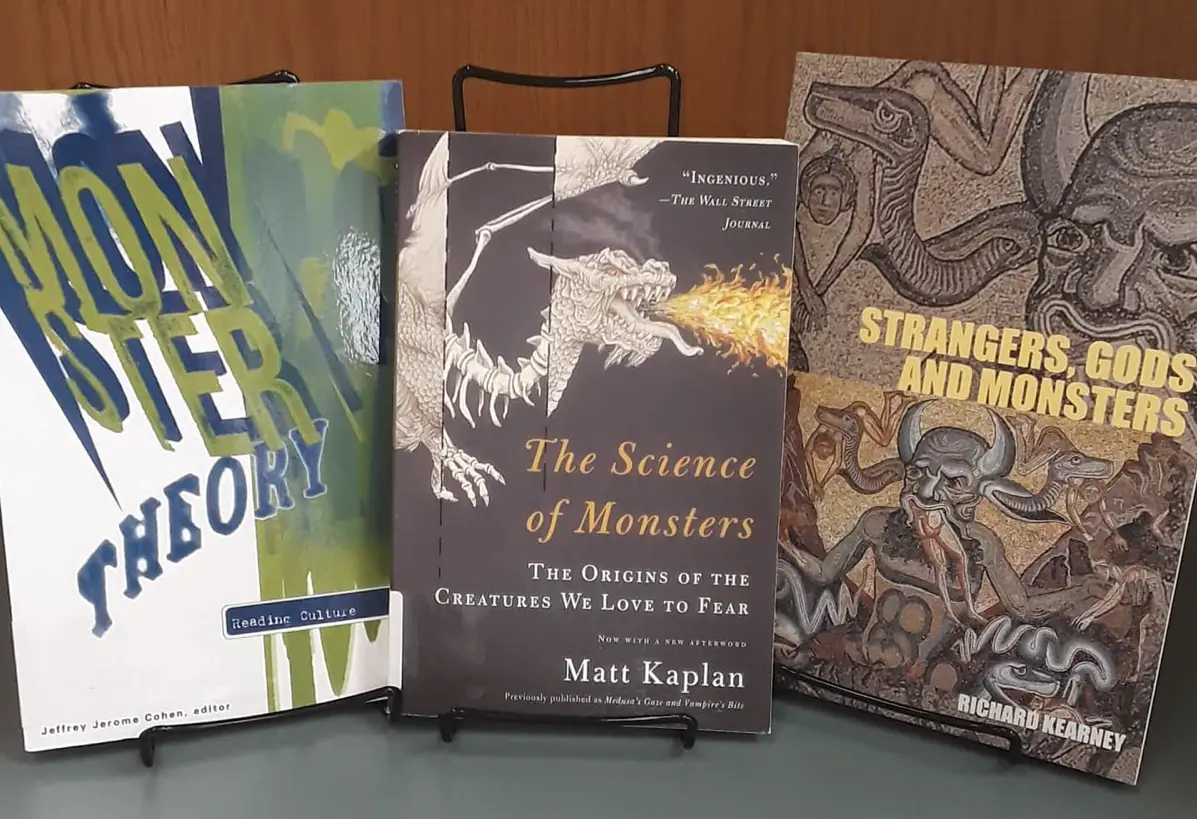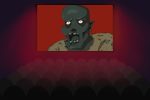What is a “monster”? The word brings to mind images of snarling chimeras, walls of zombies, swooping vampires and all sorts of beastly oddities. Ask a child and they’ll innocently tell you the Grinch, Cookie Monster or Shrek. Ask a wizened, dead-eyed worker and perhaps they’ll tell you it’s their boss or mother-in-law. However, looking at the etymology of the word provides a critical insight: “Monster” is derived from the Latin word “monstrum,” referring to a sign that something momentous or calamitous is about to happen.
In that sense, the monster is born at a “metaphorical crossroads” and represents an embodiment of a certain time, feeling and place. This is monster theory: The monsters that we think of first and the monsters that are popular now — be it werewolves or dragons — are informed by the stratification of our society, the social concerns that plague our consciousness or perhaps the results of world-changing events.
“Monster theory” — the idea that the monstrous body is a cultural body — was first conceptualized by Professor Jeffrey Jerome Cohen in his 1996 book, “Monster Theory: Reading Culture.” His founding theory is encapsulated by the seven following theses: the “monster” always escapes, the “monster” always returns, the “monster” refuses to be neatly categorized, the “monster” is indigenous to the population, the “monster” is inhuman and foreign, the “monster” is the forbidden desire, and the “monster” is one that humanity creates.
Replace “monster” in the above sentences with immigrants, women, transgender, or indigenous peoples, and you have a pretty accurate description of the narratives in our society that use a “monster” as the villain of the story (and the story, of course, being some kind of political justification or economic motivation). In an interview with Science X, Cohen argued that the mass appeal of Donald Trump was in part due to his own effectively wielded monster rhetoric: “He’s great at talking about immigrants that makes them sound like zombies. They’re mindless, they’re insatiable — we have to build a wall to keep them out.”
“The monster is difference made flesh, come to dwell among us…” (Cohen, Monster Theory Thesis IV: The Monster Dwells at the Gates of Difference).
Monstrous differences are cultural, political, racial, economic, sexual. It’s not new, by any means. Difference exaggerated into monstrous aberration has existed since the Bible (where the indigenous inhabitants of Canaan are dehumanized and depicted as monsters to justify Hebrew colonization of the Promised Land) and is often used to justify colonial and imperial aims, oiling the gears of our modern-day political machine.
A woman who oversteps her boundaries and ventures outside of the “feminine” role society assigned her? She’s now a Scylla, a Lilith, a Medusa, a Salem witch.
Godzilla, King Kong and Jurassic Park dinosaurs originated from our own anxieties over retaliation from Mother Earth — the uncontrollable forces of climate and nature that for millennia humanity has aimed to conquer. Life finds a way indeed.
And monstrous sea creatures, from the Kraken to the Giant Squid to Megalodons, tell us the boundaries of our world, a no man’s land where surpassing these borders means only a watery death. These monsters warn us against adventuring into the unknown and instead guide us to seek what is familiar and comfortable. This parable can be read as a justification for policing the stratifications of society.
“The monster always escapes because it refuses easy categorization…and so the monster is dangerous, a form suspended between forms that threatens to smash distinctions” (Cohen, Monster Theory Thesis III: The Monster Is a Harbinger of Category Crisis).
Distinctions that we cling to, traditions we preserve, boundaries and identities that we have imposed are threatened by the acceptance of new genders outside of the binary, threatened by the mixing of cultures from immigrants, threatened by the disruption of “them” versus “other,” and utterly vulnerable to any change to the idea of what it means to be “American” or what it means to be any other label.
But monsters also offer freedom — in his third thesis, Cohen writes that it is “an invitation to explore new spirals, new and interconnected methods of perceiving the world.”
There are some monsters that are special, monsters who have so thoroughly captured the imagination of the public such as vampires, zombies and werewolves.
A Lust For Fame, Wealth and Blood
In the early millennium, the rise of vampire mythology (“Buffy the Vampire Slayer,” “Twilight,” “True Blood,” “The Vampire Diaries”) and its related themes of fame and immortality, age-defying beauty and generational wealth coincided with the anxieties of entering into a new era and the rapidly burgeoning technological economies throughout the world. We anticipated a changing world, so we stuck fast to beings that will literally never change. Dracula or Edward is there to tempt us away from progress, away from improvement and change. Give up your future for tenuous immortality instead.
With “Buffy the Vampire Slayer” (1997-2003), we were introduced to the charismatic, peroxide-blond vampire Spike, who is first a major enemy, then an anti-hero, then eventually a lover and a redeemed dead hero in the series finale. Buffy, a fresh-faced teenage girl, is tasked with the responsibility to keep forces of darkness from descending upon the world. Along the way, the vampire turns from a deadly foe to a romantic interest that can’t bear to harm our protagonist when he sees how lovely and unique she is.
The premise is echoed in the “Twilight” series (2008-2012), where Bella, our new small-town protagonist, encounters Edward, the vampire who struggles to keep himself from seizing Bella’s ivory neck and draining her into a dry husk. With the power of Bella’s determination, poor judgment and uniqueness (seeing any commonalities yet?) of her shielded mind, she ends up sticking around just long enough to fall in love with the vampire and vice versa.
With “True Blood” (2008-2014), vampires are now able to come out of the coffin and into society with the synthetic blood product, “Tru Blood.” The series follows our newest female protagonist Sookie, a small-town waitress, who unsurprisingly falls in love with a centuries-old vampire and must now navigate her romantic trials and tribulations.
Our image of vampires — handsome, powerful and brooding — is based on the sixth thesis of monster theory, where Cohen explains that our fear of the monster is really a kind of desire. The monster is attractive because it also provides an escapist fantasy from our ordinary life. And we were sure nothing would go wrong, that our lust for glitz and glamor would always stay, just as vampires are eternal.
Until it wasn’t.
The Birth of The Walking Dead
The 2008-2008 global financial crisis promptly shot down our fascination with wealth and power. We no longer cared about notions of fame and fortune. The chaos of the economy, the loss of direction and whole livelihoods meant that we wanted to resonate with turmoil and establish a new world order, where capitalism is dead and communism reigns. We didn’t want to explore our vices and deal with dubious questions of morality and our dark desires. We wanted closure, a sense of order, a feeling that what we were doing was undoubtedly setting right to the world.
Enter the walking dead. It’s a gruesome, brainless monster.
It’s a simple villain — a monster to destroy without any compunction, without needing to consider tough questions of morality. There’s no redeeming feature in the faceless, inhuman masses. There’s no falling in love with something so utterly ugly. They exist solely to be killed. Or they act as a crucible where villains and heroes can join hand in hand to destroy them, a plot point that allows for unlikely heroes and allies to crawl out of the woodwork.
Take, for example, the classic “The Walking Dead” series (2010-present). The entire premise revolves around survivors of a zombie apocalypse fighting to stay alive against the constant zombie attacks and working together at all costs. Or in “Game of Thrones” (2011-2019), where the looming threat of the White Walkers from beyond the Wall means that all factions must put aside their struggles for the Iron Throne and band together to simply stay alive. There’s also “World War Z” (2013), where in order to survive the zombie threat you had to inject yourself with a deadly pathogen, or “Train to Busan” (2016), where a self-sacrificing homeless man is our first hero and selfish, wealthy individuals are as detestable as the zombies themselves.
When the economy recovered in 2015-2016, zombies didn’t release their hold on our consciousness because now there was a new outlet for our fears.
The terror of the zombie also revolves around our fears of groups, a fear that politicians are swift to capitalize on. Zombies are a collective, united in a single goal of consuming the living. There isn’t one spearhead, one king controlling the masses (aside from the Night King in “Game of Thrones”). And so it’s easy to equate a fear of zombies with a fear of an all-consuming wave, a group that threatens our way of life. Whether those are immigrants, Republicans, religious terrorists or the young generation, it’s easy to villainize a group that has no hierarchy and, therefore, no way to systematically dismantle it.
It’s rare to have a zombie movie or show where zombies are even given a chance at redemption or humanity, although shows like “iZombie” (2015) bravely (if not grotesquely) challenge this trope. In the show, the main character “Liv Moore” is a police medical examiner turned zombie who uses her undead powers for good to solve murders by experiencing the victim’s memories and receiving flashbacks. Except, she has to do it the only way zombies know how: eating brains.
This may gross some viewers out in more than just the visual sense: The idea that this zombie can be “good” is one that can be hard to digest (no pun intended). Rotten Tomatoes, in their positive critique of the show, also offers this illuminating point: “An amusing variation on the zombie trend, ‘iZombie’ is refreshingly different, if perhaps too youth-oriented to resonate with adult audiences.”
How Do Werewolves Fit In With All This?
There hasn’t been so much of a rise or fall in werewolves, in terms of media. They’ve always been there, and that might be because werewolves represent not a certain class of people, but rather represent a transition to manhood and masculinity.
Remember Jacob Black (“Twilight”) and Scott McCall (“Teen Wolf”)? It’s all tanned skin, rippling muscles and unbridled testosterone that provide a backdrop to the sometimes violent and aggressive process of the werewolf transformation. The transition from an ordinary, wimpy prepubescent to manhood is one that the werewolf transformation is an apt descriptor of, and one that series like “Teen Wolf” do well — hyper-focusing on high school drama, sexual and romantic relationships and hormone-fueled battle scenes.
The New Future of Monsters?
“Like a letter on the page, the monster signifies something other than itself: it is always a displacement, always inhabits the gap between the time of upheaval that created it and the moment into which it is received, to be born again” (Cohen, Monster Theory Thesis 1: Monstrous Body is a Cultural Body).
It’s a telling quote, timeless in its application. In our ever-changing world, where the next crisis is always on the horizon, whether it be the unpredictability of climate change, an era-defining pandemic or upheavals in political or economic spheres, the only thing we know for sure is the unknown. Studying how our fear manifests in the monsters we popularize may give us enlightening insights into understanding that fear and, from it, the ability to control and overcome not just our nightmares but the calamity that birthed them.
So, whether vampires make a comeback, a zombie resurgence occurs or whether we turn our attention to dragons, demons or devils, it’s valuable to pay attention to what our newest obsession is and the lessons we can learn about ourselves from them.

















